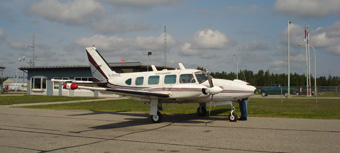
Electromagnetic surveys are conducted as a form of geophysical exploration in order to detect non-metallic minerals and valuable minerals. The mining industry uses this surveying method as a means of comparatively lower cost prospecting to acquire useful data for map development.
While electromagnetic surveys can be done either by air or on the ground, airborne electromagnetic surveys (AEM) are comparably cost-efficient and faster to perform when compared with other methods of geophysical surveys.
Employing the principle of induction, airborne active electromagnetic surveys use man-made primary electromagnetic fields. This is done by establishing a magnetic field with passing a current through a coil. The magnetic field is then measured using a receiver that consists of a sensitive electronic amplifier.
If the area is near a conductive zone, an eddy current will be induced. The closer the coil is to the conductive area, the stronger the eddy current will become. As such, a comparison is drawn between the primary and secondary currents, indicating the conductive source.
There are several degrees of magnitude held by various conductors in the scope of an electromagnetic survey. A survey will receive strong responses when it is conducted near massive sulphites. Graphite and clay, along with gravel and sand range in their conductivity levels. Airborne electromagnetic surveys that are prospecting under bedrock will discover that pyrite, graphite and pyrrhotite are commonplace.
The accuracy of an airborne electromagnetic survey is strongly dependent upon the sophistication of the data acquisition system used. For this reason, mining companies source out geophysical exploration companies that have experieince with state-of-the-art data acquisition equipment. While airborne electromagnetic surveys are cost-effective in comparison to ground magnetic surveys, it is crucial to to ensure that the data quality meets industry standards and that it can be "leveled” for further study be consulting geophysicists whose job it is to study the data and recommend areas of further exploration.
Data acquisition systems used in electromagnetic surveying should be able to respond accurately to variations in overburden conductivity, as well as to graphitic formational conductors and faults in shear zones.
When conducting an electromagnetic survey, it is important to keep in mind that certain conductive targets may be covered and their magnetic fields disrupted by factors referred to as geological noise. The following factors act as barriers in the detection of electromagnetic fields:
Therefore, it is vital that the data acquisition system selected is capable of rendering accurate results while taking stock of the above variables that can potentially skew the results of an airborne electromagnetic survey.
In addition to using electromagnet surveys as a means of mineral prospecting and data acquisition for mapping, these surveys are also employed as a way of detecting the electromagnetic fields in populated communities in order to ensure they are safe to live in. A community that has high levels of electromagnetic fields can be potentially harmful, especially to children, pregnant women and the elderly.